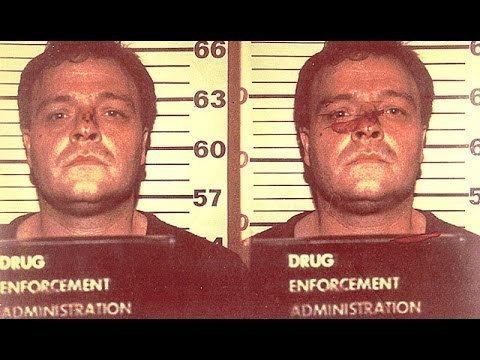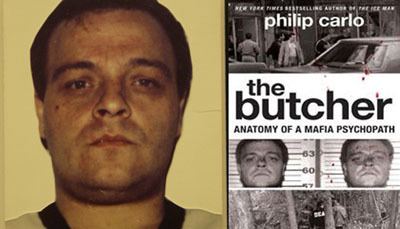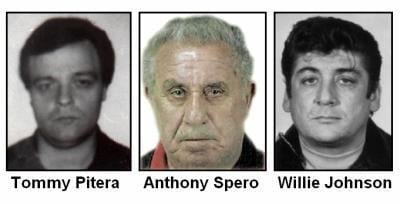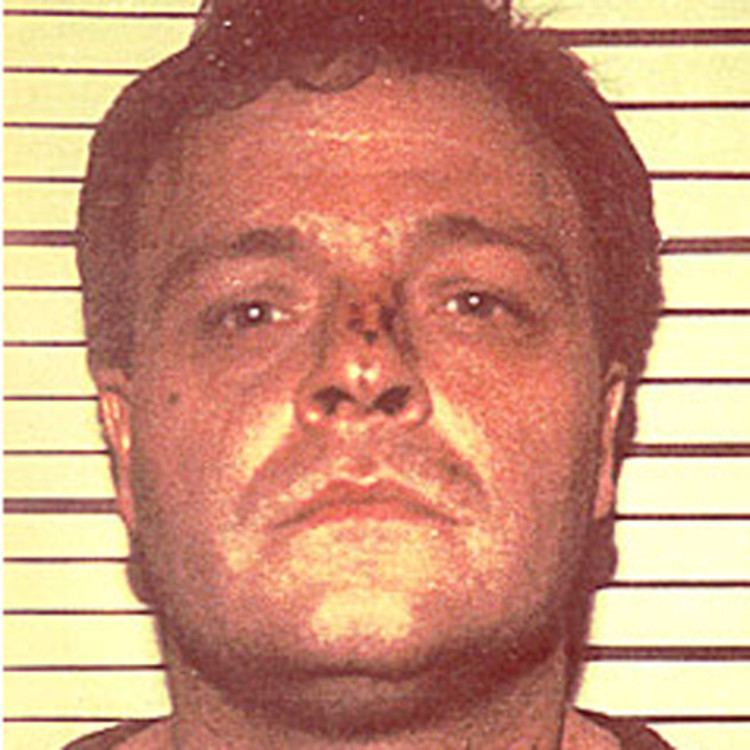Name Thomas Pitera | ||
 | ||
Born December 2, 1954 (age 70) ( 1954-12-02 ) Brooklyn, New York, U.S. Similar Louis Attanasio, Baldassare Amato, Anthony Indelicato | ||
Thomas "Tommy Karate" Pitera (born December 10, 1954) is a former Mafia hitman in the Bonanno crime family. Pitera earned a reputation as a vicious and sadistic killer who enjoyed murdering people. He was suspected by law enforcement of as many as 60 murders. He was well known for his use of karate and other martial arts when fighting which is a skill he had learned at a young age. It earned Pitera his nickname "Tommy karate".
Contents

Spotlight - Tommy "Karate" Pitera
Early years
Born in New York City, Pitera grew up in the Gravesend section of Brooklyn to parents Joe (Joseph) Pitera and Catherine. His father was a wholesale candy distributor salesman. Thomas had thick, jet-black hair with piercing blue-gray eyes and high cheekbones. He allegedly had a particularly high pitched effeminate falsetto voice that was compared by biographer Philip Carlo to Michael Jackson's but having even more falsetto. Mob associate turned informant Frank Gangi thought Pitera sounded more like Mickey Mouse or Minnie Mouse. This however is somewhat contradicted by DEA Agents who hunted Pitera, and likened his voice and mannerisms to Richard Widmark's character Tommy Udo, in the 1947 film Kiss of Death. Pitera was a quiet child who was bullied in school. He attended David A. Boody Junior High School in Gravesend, Brooklyn and left little impression with his teachers.

As a child, Pitera was a huge fan of the 1966 The Green Hornet television show and actor Bruce Lee; this began his lifelong interest in martial arts. Pitera was highly skilled in martial arts, having spent 27 months training assiduously in Tokyo, Japan where he studied under the revered Hiroshi Masumi after winning an arduous kumite competition in Sheepshead Bay, Brooklyn. He was trained to use the tonfa, nunchucks and katanas. While in Japan, he grew his hair down to his shoulders to adopt the Bruce Lee image.

After his scholarship ended, he sought work in a chopsticks factory to underwrite his stay and earn more money. This led him to acquire the nickname "Tommy Karate" by friends and mobsters. After returning from Japan, Pitera joined the Bonanno family and quickly earned a reputation for violence and murder. Pitera was one of the most feared soldiers on the streets, amongst the likes of Tony Mirra, Alphonse Indelicato, Frank Lino and Roy DeMeo, who were brutal mobsters and veteran contract killers. Pitera married Celeste Lipari, his longtime love and wanted to adopt his step daughter Nicole who was tall and beautiful just like Celeste. Pitera and Celeste attended martial arts classes together where they worked out on a regular basis.
Pitera belonged to a family faction headed by captains Alphonse "Sonny Red" Indelicato, Frank Lino, Dominick Trinchera and Philip Giaccone. This group opposed the current leadership under boss Philip Rastelli and his leading captains Joseph Massino and Dominick Napolitano. In 1981, Massino and Napolitano set up the murders of the three rival captains in a Gravenhurst, Brooklyn club owned by Sammy Gravano and Eddie Garofalo. After their deaths, Massino made peace with the rest of the leaderless faction, including Pitera. Pitera was working for Bruno Indelicato, until Bruno became a drug addict and fled New York. During the 1980s Pitera became a made man of the Bonanno family. Pitera then worked for Anthony Spero who put him in Frank Lino's crew.
Criminal career
On August 29, 1988, Pitera allegedly ambushed Wilfred "Willie Boy" Johnson as he walked ahead to their car and shot him to death. Johnson had been a close associate of Gambino crime family boss John Gotti since the two of them had been petty burglars and thieves. Johnson had also had served as a driver to Gotti after Gotti became a made man and Captain with the Gambinos. In 1985, Gotti discovered that Johnson had been a government informant since 1966. Pitera murdered Johnson as a favor to Gotti. The hit had allegedly been delegated to Pitera and fellow gunman, Vincent "Kojak" Giattino, by Gambino Capo Edward Lino. Pitera was charged with the Johnson murder, and acquitted at trial.
Pitera was close to Bonanno consigliere Anthony Spero, who headed the violent Bath Beach crew. This group was involved in extortion, loan sharking, drug dealing and murders. Pitera's crew was notorious for robbing drug dealers and then reselling their drugs. Pitera's associates, Lloyd Modell a/k/a Lorenzo Monica, and Frank Martini, a/k/a "Frankie Jupiter, murdered two Colombian Drug dealers and stole 16 kilograms of cocaine. The killers intended to drive the drug dealers' car, with the bodies, to Staten Island to bury them, but could not drive a stick shift, and so they left the car in the parking garage of an apartment building in Brooklyn. Modell used one of Pitera's guns and threw it in the bay, angering Pitera. Pitera killed Tala Siksik, a Middle-Eastern drug supplier, in his Brooklyn apartment. Pitera shot Siksik four times in the back, chopped the body up into six pieces, and then buried it at a secret dumping ground. Investigators eventually found six of Pitera's victims in a mob graveyard in Staten Island near the William T. Davis Wildlife Refuge. Pitera had decapitated the bodies and buried the heads separately to impede their identification using dental records.
Pitera's approach to murder and body disposal was cold-hearted and clinical. He used the Staten Island graveyard because he believed that the damp soil would accelerate decomposition. Pitera studied books on dissection and carried a special tool kit for cutting up bodies. He always insisted on burying corpses deep enough so that police dogs could not locate their scents. Before burying body parts, Pitera either wrapped them in plastic or placed them in suitcases. Pitera's weakness was that he enjoyed keeping jewelry and other souvenirs of his work. This went beyond Mafia culture and was classic serial killer behavior.
On June 4, 1990, Pitera was indicted for heading a drug dealing crew and for his involvement in seven murders, including the 1988 Johnson murder. Investigators alleged that Pitera had been involved in as many as 60 murders. Pitera's crew sold about 220 pounds of cocaine per year, multiple kilos of heroin and hundreds of pounds of marijuana. FBI agents discovered more than 60 automatic weapons, knives, swords, and literature such as The Hitman's Handbook and Kill or Be Killed, which dealt primarily with assassination techniques as well as torturing and dismembering cadavers, in Pitera's apartment in Gravesend, Brooklyn.
Trial
One of Pitera's crew members, Frank Gangi, the nephew of Genovese crime family Captain Rosario Gangi, decided to testify against Pitera. Frank had been arrested for driving under the influence and allegedly started reliving Pitera's worst atrocities in his mind while sitting in the holding cell. Gangi confessed to all the murders he was involved in with Pitera, and provided information on other Pitera murders. Gangi described how Pitera matter-of-factly assassinated Gangi's girlfriend Phyllis Burdi while she was passed out in bed after sharing cocaine and sex with Gangi. Pitera then cut Burdi's corpse into six pieces in the bathroom. Gangi also testified that during a fight with a drug dealer named Marek Kucharsky, Pitera pulled a knife and repeatedly stabbed Kucharsky and finally cut his throat.
In Pitera's trial, the chief prosecutor, David W. Shapiro, demanded the death sentence for the "heinous, cruel and depraved" murders committed by Pitera. He called Pitera a "heartless and ruthless killer" explaining in detail how Pitera tortured one victim by slowly, deliberately shooting him seven times in various parts of the body, in one of a series of murders carried out in a deliberately barbaric manner. The prosecution also produced a Drug Enforcement Administration (DEA) agent who testified to digging up graves containing the dismembered bodies of some of Pitera's victims.
Pitera's defense lawyer, David A. Ruhnke, urged the jury to reject the death penalty on the grounds that Pitera had no prior criminal record and that other participants in the murders were allowed to plead guilty to lesser charges. Moreover, only two of the murder victims, Richard Leone and Solomon Stern, were killed on March 15, 1989, after the Federal death penalty law went into effect. The four other murders took place earlier, so those counts carried maximum sentences of life in prison. Pitera's aunt, sister-in-law and two cousins testified on Pitera's defense that he was a loving and caring family member.
Life sentence
On June 25, 1992, Pitera was convicted of murdering six people and supervising a massive drug dealing operation in Brooklyn. However, Pitera was acquitted in the 1988 Johnson murder. During the deliberation on sentencing, the jury rejected the death penalty for Pitera. In October 1992, alluding to evidence that Pitera brutally killed his victims and dismembered their bodies, Judge Reena Raggi sentenced him to life in prison, saying, "Mr. Pitera, nobody deserves to die as these people died."
After the verdict was read, Pitera smiled and gave a thumbs up to reporters sitting in the Brooklyn courtroom; he had avoided the death penalty. However, Pitera was irritated that Gangi was petitioning Judge Raggi for a reduction of his 10-year prison sentence. As Pitera later remarked,
"Gangi said he was sorry about killing five people and that he became an informer because he wanted to start a new life. He gets 10 years, a good deal, and he goes whimpering and weeping to the judge looking for a break. If you're really sorry for killing five people, you take your punishment like a man."
Later in 1992, Judge Raggi again refused a motion to reduce Gangi's sentence. On April 3, 2012, the U.S. Second Circuit Court of Appeals denied Pitera's motion for DNA testing of the guns and other evidence in three of Pitera's murders. As of April 2017, Pitera is serving a life sentence at the United States Penitentiary McCreary in Pine Knot Kentucky. Pitera's inmate number is 29465-053.
